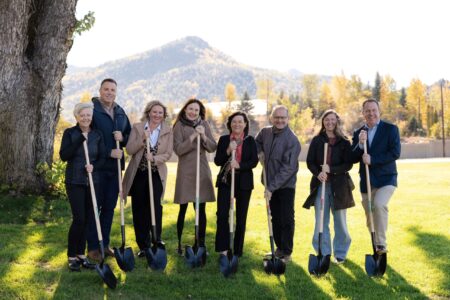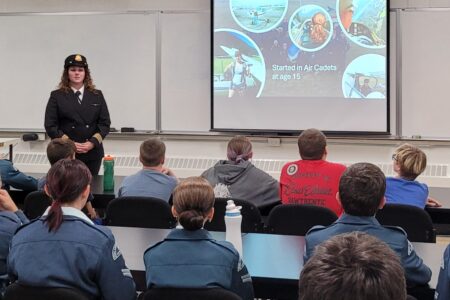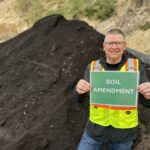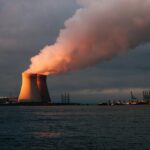What the frack is going on?
By Michael Jessen
When you’re addicted to something, you’ll do anything to satisfy your need – and so will your drug supplier.
In North America, one of our addictions is to energy, a commodity that is overabundant or in excess of demand – hence a drug on the market.
For every addiction, there is a user and a seller. In the energy business, the sellers’ motive is the same as any drug dealer – profit and lots of it.
We, the users, seem more concerned about satisfying our ever growing need for additional energy rather than curbing our addiction or questioning where the energy comes from.
How else to explain our paltry use of sunshine or wind, tidal power or geothermal to satisfy our energy cravings?
And yet, might the answer to that question lie in the fact that an energy company can’t own the sun, the wind, the tides or the steam hidden deep in the Earth?
So we, the users, keep being told we must buy our energy drugs from large, centralized, profit-hungry companies that will sell us energy only through their power lines or pipelines. So what if the price keeps going up, it’s a user pay system. Besides, there are those profits to maintain.
Now when conventional sources of a particular energy get scarce, a supplier gets creative – going offshore (literally to another country and figuratively off the coast), boiling tar sands, or drilling deep into the Earth’s crust and injecting 80,000 pounds of chemicals, 65 of which are known to be hazardous to human health, and 29 of which are known or possible human carcinogens.
That last creative is something known as hydraulic fractured drilling (a.k.a. fracking) and it’s becoming all the rage in British Columbia and the rest of North America.
Fracking ain’t what it’s cracked up to be
Ah, but with such creativity comes risk – exploitation of land owners, despoliation of a local environment, contamination of vital domestic water supplies, and escalation of greenhouse gas emissions.
But with exceptional growth potential and conventional supplies of gas near depletion, risk capital is crooning the refrain Drill, Baby, Drill and embracing hydraulic fractured drilling to market natural gas buried deep in underground shale rock.
Concerned scientists and citizens, however, are singing a different tune: My Water’s On Fire Tonight. The reason: residents from rural Alberta to Pennsylvania living next to recently fracked wells have been able to light their tap water on fire, a frightening sight seen in Josh Fox’s Academy Award-nominated film Gasland.
Invented in the 1950s by Halliburton Co., hydraulic fracking was initially used for drilling only about one in 100 natural gas wells, but now it’s being applied to most production in North America to unlock gas trapped in shale deposits. The U.S. government estimates that companies will frack at least 32,000 new gas wells annually by 2012.
The process involves drilling horizontally into shale formations up to 8,000 feet underground, then using small explosions to fracture the shale – followed by a slurry of water, sand and chemicals to free the trapped gas. A “frac-job” of a single well can utilize millions of gallons of water and sand, mixed with tens of thousands of gallons of fracking fluid chemicals.
The environmental effect of fracking
What kind of chemicals, you might rightly ask. In Canada, regulators have left groundwater drinkers in the dark. Companies call their fracking fluids “patented ingredients” and “top secret,” admitting only that they are “kitchen safe.”
Calgary-based EnCana – Canada’s second biggest energy company (after Suncor) and owner of two million acres in BC where it is exploring for gas – only disclosed product names to a Parliamentary inquiry.
It took a report for Democrats in the U.S. House of Representatives to discover the shocking truth – the chemicals included lead, petroleum distillates, methanol (a dirty air pollutant), benzene, toluene, xylene and millions of gallons of diesel. Benzene will destroy the brain and the liver, while a cup of diesel can make an Olympic-sized pool of water undrinkable.
Speaking of Olympic-sized pools, one well drilled last year in northern BC set a record for using nearly 400 Olympic swimming pools of water to fracture the shale rock and release its gas.
Then there is the water involved in the process
That leads to another question: Where will all this water come from?
Ben Parfitt, a resource policy analyst with the BC office of the Canadian Centre for Policy Alternatives, wrote: “On Feb. 15 of this year, Calgary-based Canbriam Energy Inc. quietly applied to the BC government for the rights to pull billions of litres of water out of Williston Reservoir, the ultimate source of much of our province’s hydroelectricity.
“The application was the second submitted in less than a year. In 2010, Talisman Energy, another Calgary-based company, got the ball rolling with a similar proposal. If Talisman and Canbriam get their way, they could soon withdraw a combined 7.3 billion litres of water annually out of the reservoir – an amount equivalent to draining 2,920 Olympic swimming pools each and every year.”
The Marcellus Shale – North America’s largest shale gas deposit – is a 400 million-year-old band of black rock under New York, Pennsylvania, Ohio, and Virginia.
As much as 19 million litres (five million gallons) of water is used in a typical hydraulically fractured well in the Marcellus. After experiencing contamination of their water supplies and damaging health effects, New York and Pennsylvania residents are now protesting and resisting continued drilling.
The investigative news site Pro Publica has found over 1,000 reports of water contamination near drilling sites.
Other costs and effects associated with fracking
Local communities can pay dearly to minimize drilling-related water contamination. Pennsylvania regulators estimate it will cost $12 million to pump public water to 14 Dimock families whose well water was polluted by gas drilling.
Other side effects of fracking include explosions at improperly drilled wells, chemical spills enroute to wells, millions of gallons of contaminated wastewater that needs to be disposed of somewhere, and as many as 1,300 truck trips per well with consequent air and noise pollution.
A recent report by the U.S. Ground Water Protection Council, a research group that consists mainly of state regulators, revealed that only four of the 31 drilling states it surveyed have regulations that directly address hydraulic fracturing and that no state requires companies to track the volume of chemicals left underground.
Still, natural gas is touted as the perfect “bridge fuel” in the transition away from climate damaging fossil fuels like coal and oil.
A greenhouse gas footprint 20 per cent greater than coal
The Council of Scientific Society Presidents – which represents 1.4 million scientists from more than 150 disciplines – reported to the Barack Obama administration in May 2010 that “some energy bridges that are currently encouraged in the transition from GHG-emitting fossil energy systems have received inadequate scientific analysis before implementation, and these may have greater GHG emissions and environmental costs than often appreciated.”
The Council warned that development of unconventional gas from shale deposits is an “example where policy has preceded adequate scientific study.”
Robert Howarth from Cornell University in Ithaca, New York, found exactly that in his research. Because shale gas wells leak substantial amounts of the potent greenhouse gas methane – shale gas is typically comprised of over 90 per cent methane – Howarth concludes shale gas has a greenhouse gas footprint 20 per cent greater than coal and maybe twice as great over a 20-year timeframe.
Howarth says his latest calculations show that the type of shale gas drilling taking place in parts of Texas, New York and Pennsylvania leads to particularly high emissions and would likely be just as dirty as coal.
A recent regional government study in Colorado concluded that the same methane gas tapped by drilling had migrated into dozens of water wells, possibly through natural faults and fissures exacerbated by hydraulic fracturing.
The cash cow that is natural gas
Natural gas is hailed as one of B.C.’s most valuable resources.
The Montney shale region near Dawson Creek and the Horn River Basin near Fort Nelson have an estimated 100 years of proven reserves of gas and there is more in the Liard region.
A recent joint report from the National Energy Board and the BC Ministry for Energy and Mines suggests shale gas reserves in the Horn River Basin could be twice as much as previously thought.
The report Ultimate Potential for Unconventional Natural Gas in Northeastern British Columbia’s Horn River Basin said there could be 78 trillion cubic feet of shale gas in the area.
In 2011, the BC government treasury will benefit from nearly $1.4 billion in gas exploration royalties.
That kind of money can blind a debt-ridden government to health, safety and environmental concerns. It can also blind a community that sees only employment-related benefits to the local economy.
America’s Natural Gas Alliance – a new shale gas lobby group – says natural gas accounts for 3.5 per cent of Canadian jobs and nearly 6.7 per cent of Canada’s overall GDP.
University of Montana economics professor Thomas Power, however, has found that drilling creates few local jobs. He says drilling depends on specialized workers who visit well sites but rarely settle in any one place and that their mobility undermines local economic stability.
Shale gas has come under fire in England, New Brunswick, Quebec, Saskatchewan, as well as many U.S. states. The Tyndall Centre for Climate Change Research has issued a report urging the UK government to put a moratorium on shale gas operations until the environmental implications are fully understood.
Quebec plans to impose new regulations on the shale gas industry, but a group of about 30 marchers have begun a 600-kilometre trek from Rimouski to Montreal to publicize their demand for a 20-year moratorium on shale gas development in Quebec.
The walk began May 16 and should end on June 18 after visiting 33 municipalities. New Brunswick’s environment minister is on his third trip to Pennsylvania to assess the viability of shale gas in an attempt to thwart opposition in his province.
Hear no evil, see no evil
BC’s Minister of Energy and Mines, Rich Coleman, seems impervious to any arguments against shale gas.
“I think we are going to have to find a way to manage it,” he told the Vancouver Sun. “Life is always about tradeoffs, whether we build a hydro-electric dam or dam a river, whether we put windmills in bird migration routes. We’re trading on that balance we have to strike between energy policy, the environmental policy and economic outcomes.”
When Time correspondent Bryan Walsh asked Duke Energy CEO Jim Rogers – who runs one of the biggest utilities in the U.S. – about the potential of shale gas, Rogers wondered about the long-term environmental risk: “The problem is you build a gas plant for 40 years. That’s a long bridge. What if we put in all these additional gas plants, and then it turns out that shale gas produces too much waste and too much CO2? We’d end up hooked on gas.”
Maybe we should be more careful about what source of energy we become addicted to. Maybe it’s time to tell shale gas companies to frack off.
Michael Jessen is a Nelson eco-writer and energy critic for the Green Party of BC. He can be reached by e-mail at zerowaste@shaw.ca.
Resources
- Hear My Water’s On Fire Tonight (The Fracking Song) at http://www.propublica.org/article/fracking-music-video and read the lyrics at http://explainer.net/2011/05/thefrackingsong/
- The April 2011 report by U.S. Democratic House of Representatives staff entitled Chemicals Used in Hydraulic Fracturing is at http://democrats.energycommerce.house.gov/sites/default/files/documents/Hydraulic%20Fracturing%20Report%204.18.11.pdf
- Buried Secrets, the investigative journalism site of Pro Publica is at http://www.propublica.org/series/buried-secrets-gas-drillings-environmental-threat
- More about the movie Gasland is found at http://www.gaslandthemovie.com/ and http://en.wikipedia.org/wiki/Gasland
- Energy in Depth is an industry group representing oil and gas producers that says Gasland is heavy on hyperbole and light on actual facts.
- Andrew Nikiforuk – the anti tar sands author – weighs in on fracking at http://thetyee.ca/Opinion/2011/04/20/FrackingToxins/
- Ben Parfitt’s report Fracture Lines: Will Canada’s Water be Protected in the Rush to Develop Shale Gas? written for the program on water Issues at the Munk School of Global Affairs can be read at http://www.powi.ca/pdfs/groundwater/Fracture%20Lines_English_Oct14Release.pdf
- Abrahm Lustgarten’s article about the unknowns of gas drilling is at http://www.propublica.org/article/natural-gas-drilling-what-we-dont-know-1231
- The greenhouse gas footprint of natural gas obtained from fracking is explained by Robert Howarth at http://www.springerlink.com/content/e384226wr4160653/fulltext.pdf
- Find out more about methane contamination of drinking water at http://www.nicholas.duke.edu/cgc/pnas2011.pdf
- Some research and policy recommendations about hydraulic fracturing are at http://www.nicholas.duke.edu/cgc/HydraulicFracturingWhitepaper2011.pdf
- Marcellus Shale Protest site is http://www.marcellusprotest.org/
- Fracking the Future: How Unconventional Gas Threatens Our Water, Health and Climate is at http://desmogblog.com/fracking-the-future/desmog-fracking-the-future.pdf
- Time magazine environmental correspondent Bryan Walsh’s article The Gas Dilemma, from the April 11, 2011issue is at http://www.time.com/time/health/article/0,8599,2062331,00.html
- The Tyndall Centre’s report on shale gas can be downloaded from http://www.tyndall.ac.uk/shalegasreport
- Details on North America’s shale gas fields is at http://oilshalegas.com/
- America’s Natural Gas Alliance has a website at http://www.anga.us/























